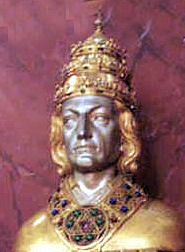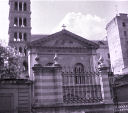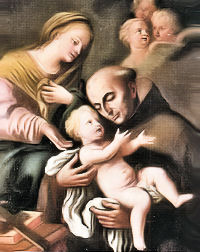Lent: March 5th
Tuesday of the Third Week of Lent
Other Commemorations: St. Lucius I, Pope and Martyr (RM); St. John Joseph of the Cross, Priest (RM)
» Enjoy our Liturgical Seasons series of e-books!
The point at which we most quickly become Pharisees is in refusing forgiveness. Failing often in greater or lesser ways, everyone must constantly ask forgiveness of God and men. Besides, the duty of forgiveness is binding upon all souls, and in regard to all. Only when fraternal correction fails and the common good requires, does authority step in to heal the damage of scandal by corrective action. Everyone else must forgive and love and keep strong the bond of brotherhood. United in love and in worship, especially at Mass and Holy Communion, we are one in Christ and sure to be heard by his Father when we pray.
The Roman Martyrology commemorates:
- St. Lucius I, Pope and Martyr (d. 254), 22nd elected pope. Except that he was born in Rome, Italy, there is little information on Lucius' birth or younger years before becoming a priest. When elected as pope in June 353, Lucius chose to use his own name. He was quickly banished from Rome for a period, but returned and died in Rome after serving 8 months in office. Even though he was only a pope for such a short period of time, he fought against the heretic Novatian (heresy Novatianism).
- St. John Joseph of the Cross, Priest (1654-1734). St. John Joseph was born on the Island of Ischia, off the coast of Naples, Italy. He entered the Alcantarine (after Peter of Alcantara) or strictest branch of the Franciscan Order at the age of 16. After being ordained, over the years he obediently took on assignments of novice master, guardian and provincial, all the while still practicing penance, putting the needs of others first, and choosing the lowliest tasks to serve his community. After suffering a stroke, he died in his convent at Naples on March 5, 1734. He was canonized in 1839 by Pope Gregory XVI.
Meditation—Do Not Judge
Let us dwell for a while on that particular sin which Our Lord emphasizes specially — the sin of judging others.
The human heart is God's secret, we simply cannot know it; yet how readily we make judgements and impute motives. We feel absolutely sure of things, we get upset or feel angry, we fall into lots of other sins because we have allowed ourselves to judge.
No matter how obvious it seems to us, remember we simply cannot know another's motivations. All we are saying in fact is that if I did such and such it would be for these reasons, therefore these reasons must be hers, too.
The hidden sin of judging, so common, so little regarded, is a tremendous obstacle to God's love. Because it is secret, because it seems such a natural thing to do, because we feel we see things aright, we have no contrition, our consciences remain untroubled. Whereas a thing of less moral significance which is obvious to ourselves and others can rack us with guilt feelings which we mistake for real sorrow.
Contrition means 'never again.' 'With all my heart I renounce this habit. I will examine myself on it daily…honestly, ruthlessly…'
Plenteous grace with thee is found
Grace to cleanse from every sin.
Let the healing streams abound.
Make and keep me pure within.
(From Jesus lover of my soul v. 4. Charles Wesley)
—Ruth Burrows, Through Him, With Him, In Him
St. Lucius I
 St. Lucius, according to the "Liber Pontificalis," was a Roman, the son of Porphyrius. When he succeeded St. Comelius, the persecution of Trebonianus Gallus was still raging, and the new Pope was exiled. Soon, however, the persecution died away and Lucius was able to return to Rome. There is extant a letter from St. Cyprian congratulating the Pope on his return from exile and praising him for his confession of Christ.
St. Lucius, according to the "Liber Pontificalis," was a Roman, the son of Porphyrius. When he succeeded St. Comelius, the persecution of Trebonianus Gallus was still raging, and the new Pope was exiled. Soon, however, the persecution died away and Lucius was able to return to Rome. There is extant a letter from St. Cyprian congratulating the Pope on his return from exile and praising him for his confession of Christ.
St. Lucius continued the policy of Cornelius in admitting repentant apostates to communion after due penance. St. Cyprian praises him for this.
The Liber Pontificalis attributes to Pope Lucius a decree ordering that two priests and three deacons should live with a bishop that they might be witnesses for him. Duchesne, however, considers this decree apocryphal.
According to the Liber Pontificalis, Pope Lucius was beheaded in the persecution of Valerian. This is almost certainly inaccurate, for Lucius died before the persecution of Valerian broke out. At any rate, St. Lucius died some time in the beginning of March 254, and was buried in the Cemetery of Calixtus. His tombstone has been discovered. The feast of St. Lucius is kept on March 4.
—Excerpted from Popes Through the Ages, by Joseph Brusher
Patronage: Copenhagen, Denmark
Highlights and Things to Do:
- Read more about Pope St. Lucius I:
- Learn more about Novatian and Novatianism at New Advent.
- St. Lucius was buried in a compartment of the papal vault in the catacombs of St. Callistus. His remains were transferred in 821 to St. Cecilia in Travestere, Rome. The sarcophagus that once held St. Lucius' remains is extant in the crypt of Santa Cecilia. It is said that some of his relics were transferred Roskilde, Denmark around 1100, and his head placed in a reliquary bust in the Saint Ansgar cathedral at Roskilde in 1910. There have been some carbon testings of the skull and the authenticity is being questioned.
St. John Joseph of the Cross
Saint John Joseph of the Cross was born on the feast of the Assumption in 1654, on the island of Ischia in the kingdom of Naples. From his childhood he was a model of virtue, and in his sixteenth year he entered the Franciscan Order of the Strict Observance, or Reform of Saint Peter of Alcantara, at Naples. Such was the edification he gave in his Order, that within three years after his profession he was sent to found a monastery in Piedmont. He assisted in its construction himself and established there the most perfect silence and monastic fervor.
One day Saint John Joseph was found in the chapel in ecstasy, raised far above the floor. He won the hearts of all his religious, and became a priest out of obedience to his Superiors. He obtained what seemed to be an inspired knowledge of moral theology, in prayer and silence. He assisted at the death of his dear mother who rejoiced and seemed to live again in his presence, and after he had sung the Mass for the repose of her soul, saw her soul ascend to heaven, to pray thereafter their God face to face.
With his superiors’ permission he established another convent and drew up rules for the Community, which the Holy See confirmed. Afterward he became a master of novices vigilant and filled with gentleness, and of a constantly even disposition. Some time later he was made Provincial of the Province of Naples, erected in the beginning of the 18th century by Clement XI. He labored hard to establish in Italy this branch of his Order, which the Sovereign Pontiff had separated from the same branch in Spain. His ministry brought him many sufferings, especially moral sufferings occasioned by numerous calumnies. Nonetheless, the Saint succeeded in his undertakings, striving to inculcate in his subjects the double spirit of contemplation and penance which Saint Peter of Alcantara had bequeathed to the Franciscans of the Strict Observance. He gave them the example of the most sublime virtues, especially of humility and religious discipline. God rewarded his zeal with numerous gifts in the supernatural order, such as those of prophecy and miracles.
Finally, consumed by labors for the glory of God, he was called to his reward. Stricken with apoplexy, he died an octogenarian in his convent at Naples, March 5, 1734. Countless posthumous miracles confirmed the sanctity and glory of the Saint, and he was canonized in 1839 by Pope Gregory XVI.
—Excerpted from Lives of the Saints for Every Day of the Year, edited by Rev. Hugo Hoever, S.O. Cist., Ph.D.
Patronage: Ischia, Italy; Naples, Italy
Symbols and Representation: Man wearing a Franciscan habit.
Highlights and Things to Do:
- Read more about St. John Joseph:

Tuesday of the Third Week of Lent
Station with San Pudenziana al Viminale (St. Pudentiana):
Today's station is in the church of St. Pudentiana, daughter of Pudens the senator. This holy virgin of Rome lived in the second century. She was remarkable for her charity, and for the zeal wherewith she sought for and buried the bodies of the martyrs. Her church is built on the very spot where stood the house in which she lived with her father and her sister St. Praxedes. St. Peter the Apostle had honored this house with his presence, during the lifetime of Pudentiana's grandfather.
For more on San Marco al Campidoglio, see:
For further information on the Station Churches, see The Stational Church.






